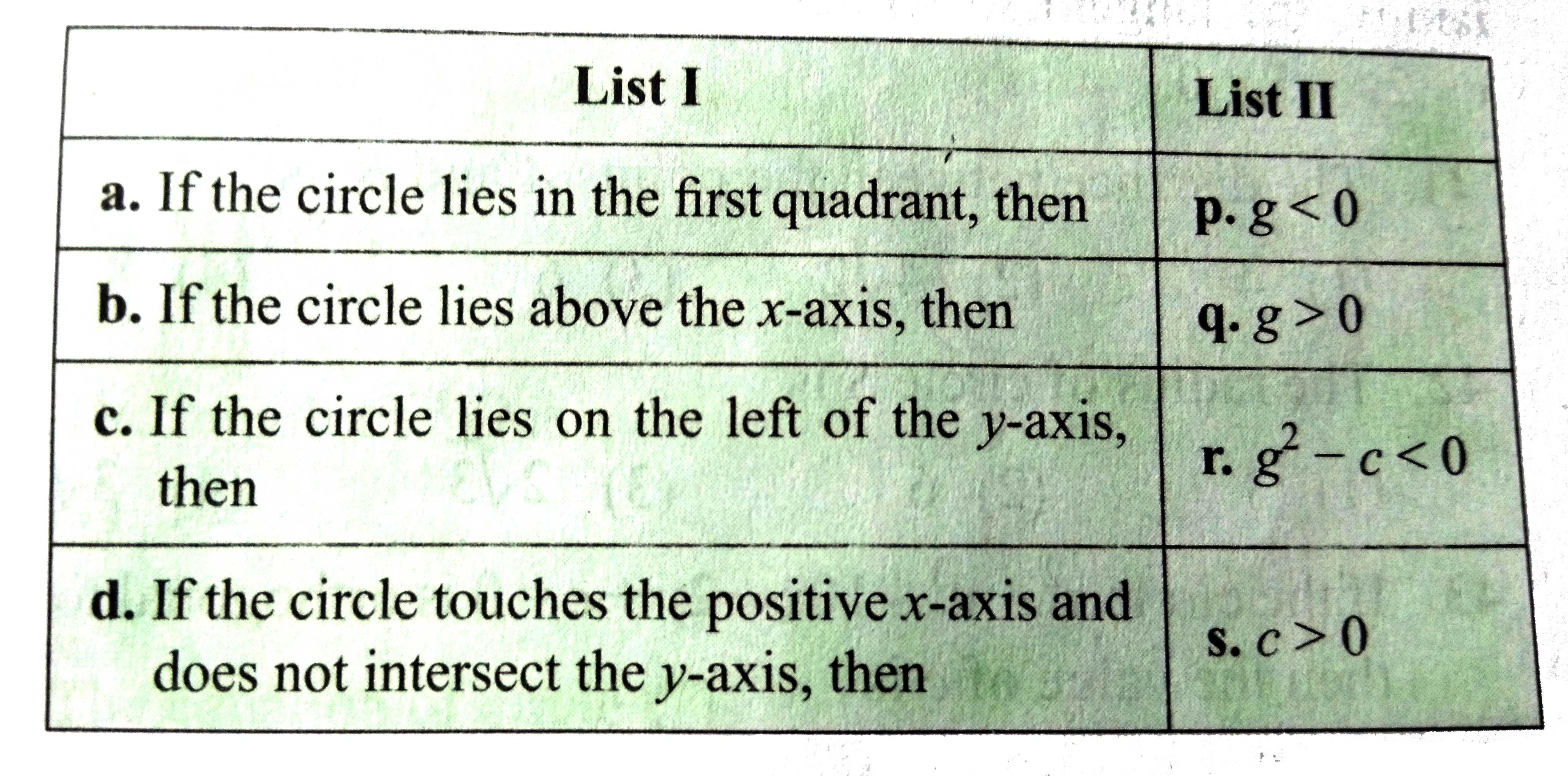If S≡x2+y2+2gx+2fy+c=0 represents a circle then show that the straight line lx+my+n=0
(i) touches the circle S=0 if
g2+f2−c=(gl+mf−n)2l2+m2
(ii) meets the circle S=0 in two points if
g2+f2−c>(gl+mf−n)2l2+m2
(iii) will not meet the circle if
g2+f2−c<(gl+mf−n)2l2+m2
To solve the problem, we need to analyze the conditions under which a straight line intersects with a circle. The equation of the circle is given as:
S=x2+y2+2gx+2fy+c=0
This can be rewritten in standard form to identify the center and radius:
1. Identify the center and radius of the circle:
- The center of the circle C is at (−g,−f).
- The radius r of the circle is given by:
r=√g2+f2−c
2. Distance from the center to the line:
The line is given by the equation:
lx+my+n=0
The distance d from a point (x1,y1) to the line ax+by+c=0 is given by:
d=|ax1+by1+c|√a2+b2
For our case, substituting (x1,y1)=(−g,−f) and a=l,b=m,c=n:
d=|l(−g)+m(−f)+n|√l2+m2=|−gl−mf+n|√l2+m2=|gl+mf−n|√l2+m2
3. Conditions for intersection:
- (i) The line touches the circle:
The line touches the circle when the distance from the center to the line equals the radius:
|gl+mf−n|√l2+m2=√g2+f2−c
Squaring both sides gives:
(gl+mf−n)2=(g2+f2−c)(l2+m2)
Rearranging leads to:
g2+f2−c=(gl+mf−n)2l2+m2
- (ii) The line meets the circle at two points:
The line intersects the circle at two points when the distance from the center to the line is less than the radius:
|gl+mf−n|√l2+m2<√g2+f2−c
Squaring both sides gives:
(gl+mf−n)2<(g2+f2−c)(l2+m2)
- (iii) The line does not meet the circle:
The line does not intersect the circle when the distance from the center to the line is greater than the radius:
|gl+mf−n|√l2+m2>√g2+f2−c
Squaring both sides gives:
(gl+mf−n)2>(g2+f2−c)(l2+m2)
Summary of Conditions:
- (i) Touches the circle if:
g2+f2−c=(gl+mf−n)2l2+m2
- (ii) Meets the circle in two points if:
g2+f2−c>(gl+mf−n)2l2+m2
- (iii) Will not meet the circle if:
g2+f2−c<(gl+mf−n)2l2+m2
- The center of the circle C is at (−g,−f).
- The radius r of the circle is given by:
r=√g2+f2−c
The line is given by the equation:
lx+my+n=0
The distance d from a point (x1,y1) to the line ax+by+c=0 is given by:
d=|ax1+by1+c|√a2+b2
For our case, substituting (x1,y1)=(−g,−f) and a=l,b=m,c=n:
d=|l(−g)+m(−f)+n|√l2+m2=|−gl−mf+n|√l2+m2=|gl+mf−n|√l2+m2
- (i) The line touches the circle:
The line touches the circle when the distance from the center to the line equals the radius:
|gl+mf−n|√l2+m2=√g2+f2−c
Squaring both sides gives:
(gl+mf−n)2=(g2+f2−c)(l2+m2)
Rearranging leads to:
g2+f2−c=(gl+mf−n)2l2+m2
The line intersects the circle at two points when the distance from the center to the line is less than the radius:
|gl+mf−n|√l2+m2<√g2+f2−c
Squaring both sides gives:
(gl+mf−n)2<(g2+f2−c)(l2+m2)
The line does not intersect the circle when the distance from the center to the line is greater than the radius:
|gl+mf−n|√l2+m2>√g2+f2−c
Squaring both sides gives:
(gl+mf−n)2>(g2+f2−c)(l2+m2)
- (i) Touches the circle if:
g2+f2−c=(gl+mf−n)2l2+m2
- (ii) Meets the circle in two points if:
g2+f2−c>(gl+mf−n)2l2+m2
- (iii) Will not meet the circle if:
g2+f2−c<(gl+mf−n)2l2+m2
Similar Questions
Show that the line lx+my+n=0 is a normal to the circles S=0 iff gl+mf=n.
View SolutionProve that the line lx+my+n=0 toches the circle (x−a)2+(y−b)2=r2 if (al+bm+n)2=r2(l2+m2)
View SolutionThe locus of th point (l,m). If the line lx+my=1 touches the circle x2+y2=a2 is
View SolutionLet x2+y2+2gx+2fy+c=0 be an equation of circle. Match the following lists :

View SolutionIf the line lx+my+n=0 touches the circle x2+y2=a2 , then prove that (l2+m2)a2=n2.
View SolutionShow that the circle S≡x2+y2+2gx+
2fy+c=0 touches the
(i) X- axis if g2=c
View SolutionThe line ax+by+by+c=0 is normal to the circle x2+y2+2gx+2fy+d=0,if
View SolutionFind the conditions that the line
(i) y = mx + c may touch the circle x2+y2=a2 ,
(ii) y = mx + c may touch the circle x2+y2+2gx+2fy+c=0.
View SolutionIf the equation x2+y2+2hxy+2gx+2fy+c=0 represents a circle, then the condition for that circle to pass through three quadrants only but not passing through the origin is f2>c (b) g2>2 c>0 (d) h=0
View SolutionIf the line lx+my−1=0 touches the circle x2+y2=a2 , then prove that (l,m) lies on a circle.
View Solution